The Maltese Falcon (1941 film)
The Maltese Falcon is a 1941 American film noir directed and scripted by John Huston[3] in his directorial debut, based on the 1930 novel of the same name by Dashiell Hammett.[4][5][6] It stars Humphrey Bogart as private investigator Sam Spade and Mary Astor as his femme fatale client. Gladys George, Peter Lorre, and Sydney Greenstreet co-star, with the latter appearing in his film debut. The story follows a San Francisco private detective and his dealings with three unscrupulous adventurers, all of whom are competing to obtain a jewel-encrusted falcon statuette.[3]
| The Maltese Falcon | |
|---|---|
.jpg) Theatrical release poster | |
| Directed by | John Huston |
| Screenplay by | John Huston |
| Based on | The Maltese Falcon by Dashiell Hammett |
| Starring | |
| Music by | Adolph Deutsch |
| Cinematography | Arthur Edeson |
| Edited by | Thomas Richards |
| Distributed by | Warner Bros. |
Release date |
|
Running time | 101 minutes |
| Country | United States |
| Language | English |
| Budget | $375,000[1][2] |
| Box office | $1.8 million[1] |
The film premiered in New York City on October 3, 1941, and was nominated for three Academy Awards. Considered one of the greatest films of all time, it was one of the first 25 films selected by the Library of Congress to be included in the National Film Registry for being "culturally, historically, or aesthetically significant".[7][8] It is a part of Roger Ebert's series The Great Movies and was cited by Panorama du Film Noir Américain as the first major film noir.[9][10]
Plot
– Introductory text appearing after the film's opening credits[11]
In San Francisco in 1941, private investigators Sam Spade and Miles Archer meet prospective client Ruth Wonderly. She claims to be looking for her missing sister, who is involved with a man named Floyd Thursby. Archer agrees to follow her that night and help get her sister back.
Spade is awakened by a phone call early in the morning and the police inform him that Archer has been killed. He meets his friend, Police Detective Tom Polhaus at the murder scene and then tries calling his client at her hotel, but she has checked out. Back at his apartment, he is grilled by Polhaus and Lieutenant Dundy, who tell him that Thursby was also murdered the same evening. Dundy suggests that Spade had the opportunity and motive to kill Thursby, who likely killed Archer. Archer's widow Iva later visits him in his office, believing that Spade shot his partner so he could have her.
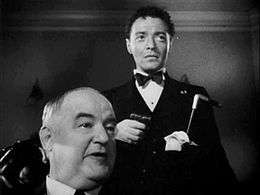
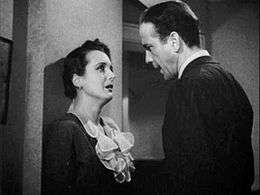
Later that morning, Spade meets his client, now calling herself Brigid O'Shaughnessy. She explains that Thursby was her partner and probably killed Archer, but claims to have no idea who killed Thursby. Spade distrusts her, but agrees to investigate the murders.
At his office, Spade meets Joel Cairo , who first offers him $5,000 to find a "black figure of a bird", then pulls a gun on him in order to search the room for it. Spade knocks Cairo out and goes through his belongings. When Cairo comes round, he hires Spade. Later that evening, Spade tells O'Shaughnessy about Cairo. When Cairo shows up, it becomes clear that Spade's acquaintances know each other. Cairo becomes agitated when O'Shaughnessy reveals that the "Fat Man" is in San Francisco.
In the morning, Spade goes to Cairo's hotel, where he spots Wilmer, a young man who had been following him earlier, and gives Wilmer a message for his boss, Kasper Gutman. When Spade goes to meet Gutman, alias the "Fat Man", in his hotel suite, Gutman will only talk about the Black Falcon evasively, so Spade pretends to throw a temper tantrum and storms out. Later, Wilmer takes Spade at gunpoint to see Gutman. Spade overpowers him, but meets Gutman anyway. Gutman relates the history of the Maltese Falcon, then offers Spade $25,000 for the bird and a quarter of the proceeds from its sale. After Spade passes out because his drink is spiked, Wilmer and Cairo come in from another room and leave with Gutman.
On coming round, Spade searches the suite and finds a newspaper with the arrival time of the freighter La Paloma circled. He goes to the dock, only to find the ship on fire. Later, the ship's captain, Jacobi, shot several times, staggers into Spade's office before dying. The bundle he was clutching contains the Maltese Falcon.
O'Shaughnessy calls the office, gives an address, then screams before the line goes dead. Spade stashes the package at the bus terminal, then goes to the address, which turns out to be an empty lot. Spade returns home and finds O'Shaughnessy hiding in a doorway. He takes her inside and finds Gutman, Cairo, and Wilmer waiting for him, guns drawn. Gutman gives Spade $10,000 for the Falcon, but Spade tells them that part of his price is someone he can turn over to the police for the murders of Thursby and Captain Jacobi, suggesting Wilmer, whom Gutman confirms actually did shoot both. After some intense negotiation, Gutman and Cairo agree and Wilmer is knocked out and disarmed.
Just after dawn, Spade calls his secretary, Effie Perine, to bring him the bundle. However, when Gutman inspects the statuette, he finds it is a fake and Wilmer escapes during the tumult. Recovering his composure, Gutman invites Cairo to return with him to Istanbul to continue their quest. After they leave, Spade calls the police and tells them where to pick up the pair. Spade then angrily confronts O'Shaughnessy, telling her he knows she killed Archer to implicate Thursby, her unwanted accomplice. She confesses, but begs Spade not to turn her over to the police. Despite his feelings for her, Spade gives O'Shaughnessy up.
Cast
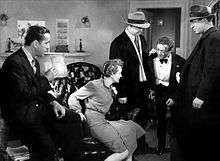
- Humphrey Bogart as Sam Spade
- Mary Astor as Ruth Wonderly/Brigid O'Shaughnessy
- Gladys George as Iva Archer
- Peter Lorre as Joel Cairo
- Barton MacLane as Lieutenant Dundy
- Lee Patrick as Effie Perine
- Sydney Greenstreet as Kasper Gutman
- Ward Bond as Detective Tom Polhaus
- Jerome Cowan as Miles Archer
- Elisha Cook Jr. as Wilmer Cook
- James Burke as Luke, hotel detective
- Murray Alper as Frank Richman, taxi driver
- John Hamilton as District Attorney Bryan
- Walter Huston as Captain Jacoby (uncredited)
Background
Hammett once worked as a private detective for the Pinkerton Detective Agency in San Francisco, and he used his birth name "Samuel" for the story's protagonist. He wrote of the book's main character in 1934:
Spade has no original. He is a dream man in the sense that he is what most of the private detectives I worked with would like to have been, and, in their cockier moments, thought they approached.
Other characters in The Maltese Falcon were based on people whom he met or worked with during that time.[12] The novel was serialized in five parts in Black Mask during 1929 and 1930 before being published in book form in 1930 by Alfred A. Knopf. It was first filmed the next year and for a second time as Satan Met a Lady in 1936 but rewritten as a light comedy with many elements of the story changed.[13][14]
Production
Casting
Bogart was not the first choice to play Sam Spade. Producer Hal B. Wallis initially offered the role to George Raft, who rejected it because he did not want to work with an inexperienced director, choosing instead to make Manpower with director Raoul Walsh and co-starring Edward G. Robinson and Marlene Dietrich. This was one of several roles Raft turned down in movies which ended up being classics.[15]
Huston was grateful that Bogart had quickly accepted the role, and the film helped to consolidate their lifelong friendship and set the stage for collaboration on other films. Bogart's convincing interpretation became the archetype for a private detective in the film noir genre, providing him acclaim and solidifying his onscreen persona. Ingrid Bergman watched Maltese Falcon over and over again while preparing for Casablanca in order to learn how to interact and act with Bogart.[16]
The character of sinister "Fat Man" Kasper Gutman was based on Maundy Gregory, an overweight British detective-entrepreneur who was involved in many sophisticated endeavors and capers, including a search for a long-lost treasure like the jeweled Falcon.[16] However, the character was not easily cast, and it took some time before producer Hal Wallis suggested that Huston screen test Sydney Greenstreet, a veteran stage actor who had never appeared in film before. Greenstreet was 61 years old and weighed between 280 and 350 pounds, and he impressed Huston with his sheer size, distinctive abrasive laugh, bulbous eyes, and manner of speaking.[16] The character of Joel Cairo was based on a criminal whom Hammett arrested for forgery in Pasco, Washington in 1920.[12]
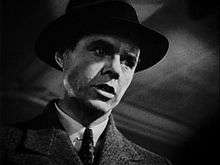
Preparation
During his preparation for The Maltese Falcon, his directorial debut, John Huston planned each second of the film to the very last detail, tailoring the screenplay with instructions to himself for a shot-for-shot setup, with sketches for every scene, so filming could proceed fluently and professionally.[17] Huston was adamant that the film keep to schedule and that everything be methodically planned to the fullest to ensure that the film never went over budget. The film was shot quickly, and finished completely for less than $400,000.[18] By providing the cast with a highly detailed script, Huston was able to let them rehearse their scenes with very little intervention.
Such was the extent and efficacy of his preparation of the script that almost no line of dialogue was eliminated in the final edit of the film.[19] Except for some exterior night shots, Huston shot the entire film in sequence,[20] which greatly helped his actors. The shooting went so smoothly that there was actually extra time for the cast to enjoy themselves; Huston brought Bogart, Astor, Bond, Lorre and others to the Lakeside Golf Club near the Warner lot to relax in the pool, dine, drink and talk until midnight about anything other than the film they were working on.
Huston used much of the dialogue from the original novel. The only major section of the novel which wasn't used at all in the film is the story of a man named "Flitcraft", which Spade tells to Brigid while waiting in his apartment for Cairo to arrive.[21] Huston removed all references to sex that the Hays Office had deemed to be unacceptable. Huston was also warned not to show excessive drinking. The director fought the latter, on the grounds that Spade was a man who put away a half bottle of hard liquor a day and showing him completely abstaining from alcohol would mean seriously falsifying his character.[16]
Cinematography
Director of Photography Arthur Edeson used low-key lighting and arresting angles to emphasize the nature of the characters and their actions, such as the scene where Gutman explains the history of the Falcon to Spade, drawing out his story so that the knockout drops in Spade's drink will take effect.[16] Roger Ebert describes this scene as "an astonishing unbroken seven-minute take",[9] and script supervisor Meta Wilde remarked of this scene:
It was an incredible camera setup. We rehearsed two days. The camera followed Greenstreet and Bogart from one room into another, then down a long hallway and finally into a living room; there the camera moved up and down in what is referred to as a boom-up and boom-down shot, then panned from left to right and back to Bogart's drunken face; the next pan shot was to Greenstreet's massive stomach from Bogart's point of view.… One miss and we had to begin all over again.[22]
Props
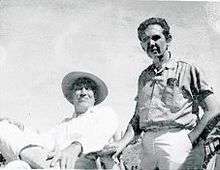
Fred Sexton (June 3, 1907 – September 11, 1995) was an American artist and sculptor of the Maltese Falcon statuette prop for the film.[23] He also taught art and headed the Art Students League in Los Angeles[24] between 1949 and 1953.[25]
The "Maltese Falcon" itself was based on the "Kniphausen Hawk",[26] a ceremonial pouring vessel made in 1697 for Georg Wilhelm von Kniphausen, Count of the Holy Roman Empire. It is modeled after a hawk perched on a rock and is encrusted with red garnets, amethysts, emeralds, and sapphires. It is currently owned by the Cavendish family[27] and is part of the collection at Chatsworth House.[26]
Several 11.5-inch (29 cm) tall falcon props were made for the film. Studio chief Jack L. Warner gave a metal falcon to William Conrad; it was auctioned in December 1994 for $398,500,[28] the highest price paid for a film prop at that time.[29] A 45-pound metal prop that appeared in the film was sold at auction on November 25, 2013 for over $4 million.[30]
Reception
Critical
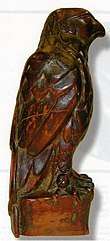
Following a preview in September 1941, Variety called it "one of the best examples of actionful and suspenseful melodramatic story telling in cinematic form":
Unfolding a most intriguing and entertaining murder mystery, picture displays outstanding excellence in writing, direction, acting and editing—combining in overall as a prize package of entertainment for widest audience appeal. Due for hefty grosses in all runs, it's textured with ingredients presaging numerous holdovers in the keys—and strong word-of-mouth will make the b.o. wickets spin.[31]
Upon its release, Bosley Crowther described it as "the best mystery thriller of the year", saying "young Mr. Huston gives promise of becoming one of the smartest directors in the field"; according to Crowther, "the trick which Mr. Huston has pulled is a combination of American ruggedness with the suavity of the English crime school—a blend of mind and muscle—plus a slight touch of pathos".[14] The widely read trade paper The Film Daily agreed with Crowther's assessment of the film and focused special attention as well on Huston's directorial debut. In its 1941 review of the "beautifully made" production, the paper asserted: "John Huston's direction of his own screenplay is as brilliant as any of the jewels which are alleged to encrust the falcon whose possession is the crux of the story".[32]
As a measure of modern or more current reactions to the film, the review-aggregation website Rotten Tomatoes reports The Maltese Falcon holds an approval rating of 100% based on 55 reviews, with an average rating of 9.06/10. The site's critics consensus reads: "Suspenseful, labyrinthine, and brilliantly cast, The Maltese Falcon is one of the most influential noirs—as well as a showcase for Humphrey Bogart at his finest."[33] On Metacritic, the film has a weighted average score of 96 out of 100, based on 15 critics, indicating "universal acclaim".[34]
Box office
According to Warner Bros.' records the film earned $967,000 domestically and $805,000 foreign.[1]
Awards
The film received three nominations at the 14th Academy Awards: Best Picture, Sydney Greenstreet for Best Supporting Actor, and John Huston for Best Adapted Screenplay.
Proposed sequel
As a result of the film's success, Warner Bros. immediately made plans to produce a sequel entitled The Further Adventures of the Maltese Falcon, which Huston was to direct in early 1942. However, due to Huston's high demand as a director and unavailability of the major cast members, the sequel was never made.[16]
Legacy
In 1989, The Maltese Falcon was selected for preservation in the United States National Film Registry by the Library of Congress as being "culturally, historically, or aesthetically significant", going in the first year of voting.[8] Roger Ebert added it to his "Great Movies" list.[9]
American Film Institute recognition
- 1998 – AFI's 100 Years…100 Movies – No. 23
- 2001 – AFI's 100 Years…100 Thrills – No. 26
- 2003 – AFI's 100 Years…100 Heroes and Villains:
- Kasper Gutman – Nominated Villain
- Brigid O'Shaughnessy – Nominated Villain
- 2005 – AFI's 100 Years…100 Movie Quotes:
- "The stuff that dreams are made of." – No. 14. The expression is based on Act 4 of William Shakespeare’s play The Tempest, wherein Prospero says, "We are such stuff / As dreams are made on".
- "You're good, you're very good." – Nominated
- 2007 – AFI's 100 Years…100 Movies (10th Anniversary Edition) – No. 31
- 2008 – AFI's 10 Top 10 – No. 6 Mystery Film
Soundtrack
| The Maltese Falcon | |
|---|---|
| Soundtrack album by | |
| Genre | Classical |
| Length | 75:41 |
Adolph Deutsch wrote the score for the film.[35]
Track listing
|
01."Main Title" – 2:07 |
12."The Phone" – 1:48 |
22."Blackmail Letter" – 1:26 |
32."Main Title" – 1:47 |
Adaptations
Perhaps the earliest radio adaptation of The Maltese Falcon was on the Silver Theater broadcast on the CBS radio network on February 1, 1942, with Bogart as star.[36] Philip Morris Playhouse staged an adaptation August 14, 1942, with Edward Arnold starring.[37] CBS later created a 30-minute adaptation for The Screen Guild Theater with Bogart, Astor, Greenstreet and Lorre all reprising their roles. This radio segment was originally released on September 20, 1943, and was played again on July 3, 1946.[38]
See also
- The Black Bird, 1975 comedy sequel
- Tribute of the Maltese Falcon
- List of films with a 100% rating on Rotten Tomatoes, a film review aggregator website
References
- Warner Bros financial information in The William Shaefer Ledger. See Appendix 1, Historical Journal of Film, Radio and Television, (1995) 15:sup1, 1-31 p 22 DOI: 10.1080/01439689508604551
- "The Maltese Falcon". AFI Catalog of Feature Films (American Film Institute). Retrieved August 8, 2015. claims $381,000 was the budget
- "The Maltese Falcon 1941". Turner Classic Movies. Retrieved September 18, 2016.
- Hammett, Dashiell (1992). The Maltese Falcon. New York City: Vintage Crime/Black Lizard. ISBN 978-0679722649.
- "The Maltese Falcon". Variety. September 30, 1941. p. 9. Retrieved January 6, 2020.
- Harrison's Reports film review; October 4, 1941, page 159.
- "ENTERTAINMENT: Film Registry Picks First 25 Movies". Los Angeles Times. Washington, D.C. September 19, 1989. Retrieved April 22, 2020.
- "Complete National Film Registry". Library of Congress.
- Ebert, Roger (May 13, 2001). "The Maltese Falcon (1941)". Chicago Sun-Times. Retrieved February 24, 2007 – via rogerebert.com.
- Sklar, Robert (1993). Film: An International History of the Medium. New York: Prentice Hall. p. 305. ISBN 978-0130340498. Retrieved January 6, 2020.
- Luhr, William (1995). The Maltese Falcon. Dir. John Huston. Rutgers Films in Print. New Brunswick: Rutgers UP. p. 27. ISBN 978-0813522371. Retrieved August 5, 2010.
- Introduction to The Maltese Falcon (1934 edition)
- Huston, John (1980). An Open Book. New York: Alfred A. Knopf. p. 78.
- Crowther, Bosley (October 4, 1941). "'The Maltese Falcon', a Fast Mystery-Thriller With Quality and Charm, at the Strand". The New York Times. Retrieved November 15, 2011.
- Vagg, Stephen (February 9, 2020). "Why Stars Stop Being Stars: George Raft". Filmink.
- Mills, Michael (1998). "The Maltese Falcon". Palace Classic Films. moderntimes.com. Archived from the original on January 26, 2007. Retrieved February 17, 2008.
- Behlmer, Rudy (1990). Behind the Scenes: The Making Of... Hollywood: Samuel French. p. 144. ISBN 978-0573606007.
- Thompson, David (2017). Warner Bros: The Making of an American Movie Studio. New Haven, London: Yale University Press.
- Huston decided that the final scene of the novel and the script, in which Spade returns disgustedly to Iva Archer, would not be filmed, believing the film should end the way it was, and thus making Spade's character more honorable as the story progressed. Lax, Eric. Audio commentary for Disc One of the 2006 three-disc DVD special edition of The Maltese Falcon.
- Behlmer, p. 145.
- "Hammett: The Flitcraft Story". Ed Fitzgerald's Unfutz. November 29, 2006.
- Grobel, Lawrence (July 1, 2014). The Hustons. New York: Shyhorse. ISBN 978-1629142890. Retrieved January 6, 2020.
- "Interview with Michele Fortier, Daughter of Maltese Falcon Prop Artist Fred Sexton". YouTube.com. Retrieved September 19, 2013.
- "The Los Angeles Art Students League".
- South, Will; Yoshiki-Kovinick, Marian & Armstrong-Totten, Julia (2008). A Seed of Modernism: The Art Students of Los Angeles, 1906-1953. Pasadena Museum of California Art. pp. 123–124. ISBN 978-1597140768.
- Nikkhah, Roya (February 27, 2010). "Treasures of Chatsworth House Unveiled Derbyshire's grand dame of a stately home shines forth after a glamorous £15million top-to-toe overhaul". The Daily Telegraph. Retrieved January 6, 2020.
- "Bellagio Gallery of Fine Art to exhibit one of England's most famous private collections". Bellagio. January 18, 2004. Archived from the original on September 10, 2012. Retrieved October 30, 2011 – via PR Newswire.
- "Maltese Falcon Prop Sells For $398,500 At Auction". Orlando Sentinel. December 7, 1994.
- Burrough, Bryan. "The Mystery of the Maltese Falcon, One of the Most Valuable Movie Props in History". Vanity Fair. Retrieved February 1, 2018.
- "'Maltese Falcon' Bird Statuette Sold for More Than $4 Million". PBS. PBS NewsHour. November 25, 2013. Retrieved January 6, 2020.
- "The Maltese Falcon". Variety. September 29, 1941. Retrieved November 15, 2011.
- "The Maltese Falcon". The Film Daily. New York City. September 30, 1941. p. 8. Retrieved January 13, 2019.
- "The Maltese Falcon". Rotten Tomatoes. Retrieved January 12, 2019.
- "The Maltese Falcon Reviews". Metacritic. Retrieved August 16, 2020.
- William Luhr, The Maltese Falcon, Rutgers University Press, 1995, p.120
- "On KFAB". The Lincoln Star. February 1, 1942. p. 32. Retrieved March 31, 2015 – via Newspapers.com.
- "Arnold Is Playhouse Guest Star". Harrisburg Telegraph. August 8, 1942. p. 25. Retrieved August 18, 2015 – via Newspapers.com.
- Terrace, Vincent (September 2, 2015). Radio Programs, 1924–1984: A Catalog of Over 1800 Shows. Jefferson, NC: McFarland. ISBN 978-1476605289.
External links
| Wikimedia Commons has media related to The Maltese Falcon (1941 film). |
| Wikiquote has quotations related to: The Maltese Falcon (1941 film) |
- The Maltese Falcon essay by Richard T. Jameson on the National Film Registry website
- The Maltese Falcon at the American Film Institute Catalog
- The Maltese Falcon on IMDb
- The Maltese Falcon at the TCM Movie Database
- The Maltese Falcon at AllMovie
- The Maltese Falcon at Rotten Tomatoes
- The Maltese Falcon at Metacritic
- Books about The Maltese Falcon from film.virtual-history.com
Streaming audio
- The Maltese Falcon on Lux Radio Theater: February 8, 1943
- The Maltese Falcon on Screen Guild Theater: September 20, 1943